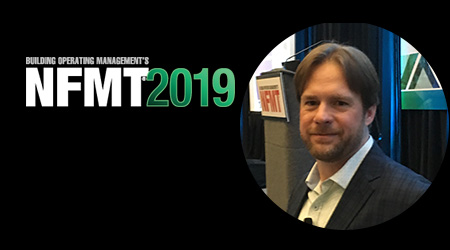
Specifying New Technology Options For Existing Facilities
April 18, 2019
The past few years have seen a wealth of new products enter the facility market. There has been a lot of interest in the new technologies, but adoption hasn’t kept pace. “We have a lot of technology,” noted John Rimer, president, FM360. “But a lot of facility organizations are still working the same way they did 10 or 20 years ago.” He spoke at the opening general session at NFMT 2019, entitled “Building Technology Has Advanced - It’s Time We Catch Up”
There are many reasons that new technologies aren’t adopted as quickly by facility managers as might be expected: tight budgets, concerns about making the wrong choice in an environment where new technology options appear regularly, hesitation about moving to the cloud, and concerns about the staying power of some new technology companies. But facility managers have a wider range of options for starting with new technology than in the past. Here are several examples, drawn from conversations with exhibitors on the NFMT show floor:
- Some companies are going beyond pilot projects. Fluke is conducting “experiments” at customer sites, installing new products at no charge. The experiments offer a way to understand challenges and limits on both the product side and the customer side, said Kevin Clark, vice president, Fluke. “We put a little more on the table than we usually would,” Clark said, including sharing information about product application issues that the company is struggling with. The result is that Fluke discovers things that may help improve the product or make it more successful in other applications.
- In a similar approach, Sodexo has created a lab at a client facility in Boston, where Sodexo installs technology like new sensors at no charge, so that it can test the new devices. If they work well, that knowledge can be applied to other facility clients, said Eric Jouane, vice president, North American facilities management platform.
- Fluke is also co-developing products for large customers, Clark said. The products are preconfigured for use across the customer’s entire portfolio.
- A tight budget can be an obstacle to trying new products. Subscription-based products offer a way to address that issue. WINT Water Intelligence uses machine learning/artificial intelligence to help detect water leaks, said Alon Geva, CEO. The company uses a subscription, or SaaS (software as a service) model. What’s more, the subscription approach provides a “comfort factor,” said Yaron Dyclan, chief product and strategy officer, because users can drop it if they aren’t satisfied.
- One concern about new products is that the facility will be locked in to a single vendor. Facility managers can get some peace of mind on that count by looking for products that adhere to vendor independent standards. One example is Microshare, which offers Building IoT bathroom predictive cleaning solutions using the Low Power, Long Range LoRaWAN network. the LoRaWAN protocol is a open global standard for secure, carrier-grade IoT LPWAN connectivity.
Ed Sullivan is editor-in-chief of Building Operating Management.
Next
Read next on FacilitiesNet












